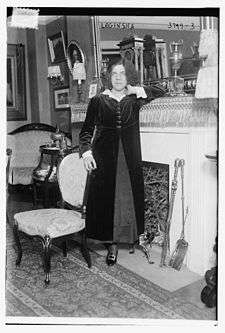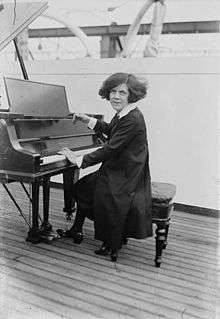Ethel Leginska

Ethel Leginska née Liggins (13 April 1886 – 26 February 1970) was a British pianist, composer, conductor and music educator, having among her students harpsichordist Gavin Williamson, a long-time student of Artur Schnabel and Theodor Leschetizky, James Henry Fields, Daniel Pollack and Bruce Sutherland.[1] She was a pioneer of women's opportunity in music performance and conducting,[2] being the first woman in music history to conduct many of the world's leading orchestras.[1]
Life and career
Ethel Liggins was born in Hull, Yorkshire, England,[3] to Thomas and Annie Peck Liggins.[1] With support from wealthy patron Mary Emma Wilson, she attended the Hoch conservatory in Frankfurt, where she studied piano under James Kwast, and composition under Bernhard Sekles and Iwan Knorr.[1] She also studied in Vienna in 1900 with Theodor Leschetizky.[3] She went on tour in Australia in 1905,[4] and performed in Europe under the stage name Ethel Leginska from 1906 on, as suggested by Lady Maud Warrende.[3] She married American Roy Emerson Whittern in 1907 and had one son,[1] but the couple divorced in 1918 and Leginska resumed her career, making her American debut in New York's Aeolian Hall on 20 January 1913.[1] After an unsuccessful custody fight for her son Cedric,[1] she became outspoken about inadequate opportunities for women.[1]
In 1923, Leginska went to London to study orchestral conducting with Eugène Aynsley Goossens.[1] The following year she worked with Robert Heger, conductor of the Bavarian State Opera in Munich and conducted a performance of her orchestral suite Quatre sujets barbares.[1] In 1925, she made her debut as a conductor in the United States with the New York Symphony Orchestra in the Carnegie Hall.[1] She ended her performing career in 1926 and turned to conducting, composing and teaching. She had been working as a conductor since the early twenties, using her status as a performer to book engagements as a guest conductor of European orchestras by promising to play as soloist.

After conducting the New York Symphony Orchestra,[5] Leginska continued to find engagements in American cities including Boston and Los Angeles.[5] She established the Boston Philharmonic Orchestra and the Boston English Opera Company,[5] founded the National Women's Symphony Orchestra in New York in 1932 and served as director of the Chicago Women's Symphony Orchestra.[5] In the late 1930s she lived in London and Paris before settling in 1939 in Los Angeles, where she founded the Concert Office New Ventures in Music,[1] set up a studio and worked as a piano teacher. Leginska Ethel died in Los Angeles of a stroke on 26 February 1970, aged 83.[6][7]
As professor
After 1935, work opportunities seem to decrease for Leginska. In 1938, she lived in London and Paris where she taught, before finally settling in Los Angeles in 1939. There she worked as a piano teacher of notable reputation. Among Leginska's students were Alexander Frey, James Henry Fields, Daniel Pollack, Bruce Sutherland,[8] and harpsichordist Gavin Williamson, a long-time student of Artur Schnabel and Theodor Leschetizky.
In a book by Harriette Brower, Piano Mastery: Talks with Master Pianists and Teachers published in 1915, the following is said about Leginska: "I believe in absolute freedom in all parts of the arm, shoulder to fingertips. Rigidity seems to me the most reprehensible thing when playing the piano, which is the most common of all kinds of performers default."
During the war in 1943, she founded, along with Mary Holloway, the concert agency New Ventures in Music with the French slogan: Youth Works![1] The agency organized concerts with the Little Symphony Orchestra, where her students improved their abilities. With the support of many musical personalities, her concerts were a great success. She played both Bach's Well-Tempered Clavier, and the complete Beethoven's sonatas and variations, as well as the works of Frédéric Chopin and Robert Schumann.[1]
In 1957 in Los Angeles, Leginska gave the premiere of her opera The Rose and the Ring, based on William Makepeace Thackeray's story of the same name, written a quarter of a century earlier.[1]
As composer
In addition to her concert career, Leginska took courses in harmony with Rubin Goldmark from 1914,[1] and lessons in composition with Ernest Bloch in New York from the summer of 1918 on.[1] She soon followed these classes with composition of a range of pieces for piano and chamber ensembles.
The first work performed in public, which was something rare for a woman at the time, was a string quartet inspired by four texts by the Indian poet Tagore,[1] which won a composition prize in the Berkshire Chamber Music Festival Competition. The symphonic poem Beyond the Fields We Know with the title borrowed from poet Lord Edward Plunkett came shortly after. The Gargoyles of Notre Dame was inspiered by Victor Hugo's novel The Hunchback of Notre Dame, and her four-movement orchestral suite Quatre sujets barbares is a musical work inspired by the life and paintings of French artist Paul Gauguin.[1]
Works
Ethel Leginska's body of work is relatively small, consisting of piano pieces and songs, excluding her orchestral works and three operas. Among her major compositions are quartets for strings and piano, four Poems and six nursery rhymes. Many of her works are still unpublished.
Melodies
Orchestral
|
Chamber music
Piano
Opera
|
See also
References
- 1 2 3 4 5 6 7 8 9 10 11 12 13 14 15 16 17 18 19 Love Griffin, Melodie. "Ethel Leginska: Pianist, Feminist, Conductor xtraordinaire, and Composer" (PDF). Sail.cnu.edu. CNU.
- ↑ Phenix, Katharine (1996). Subject guide to women of the world.
- 1 2 3 Marguerite Broadbent, Terry Broadbent. "Leginska: Forgotten Genius of Music The Story of a Great Musician". Leginska.org. Leginska.org.
- ↑ "Town Hall Sydney". The Freeman's Journal (Sydney, NSW). 9 September 1905.
- 1 2 3 4 "ETHEL LEGINSKA (1883-1970) British pianist". Forte piano pianissimo.com. Forte piano pianissimo.
- ↑ "ETHEL LEGINSKA (Ethel Liggins)". Retrieved 31 December 2010.
- ↑ Sadie, Julie Anne; Samuel, Rhian (1994). The Norton/Grove dictionary of women composers (Digitized online by GoogleBooks). ISBN 9780393034875. Retrieved 31 December 2010.
- ↑ "Ethel Leginska". Retrieved 12 July 2014.
External links
-
 Media related to Ethel Leginska at Wikimedia Commons
Media related to Ethel Leginska at Wikimedia Commons - Ethel Leginska plays Moszkowski's Valse Nr. 1, Op. 34 on the Duo-Art piano at YouTube
|